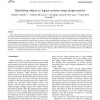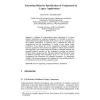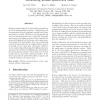126 search results - page 5 / 26 » Reverse engineering of object oriented code |
IWPC
1997
IEEE
13 years 11 months ago
1997
IEEE
Many organisations are migrating towards object-oriented technology. However, owing to the business value of legacy software, new object-oriented development has to be weighed aga...
ICSM
2000
IEEE
14 years 12 hour ago
2000
IEEE
Several reverse engineering methods for recovering objects from legacy systems have been proposed in the literature, but most of them neglect to identify the relationships among t...
CBSE
2009
Springer
14 years 8 days ago
2009
Springer
A challenge of componentizing legacy applications is to extract behavior specification of suggested components. It is desirable to preserve a relation between the original structur...
PASTE
2005
ACM
14 years 1 months ago
2005
ACM
UML sequence diagrams are commonly used to represent the interactions among collaborating objects. Reverse-engineered sequence diagrams are constructed from existing code, and hav...
SIGDOC
1992
ACM
13 years 11 months ago
1992
ACM
Softwareprofessionals rely on internaldocumentationas an aid in understanding programs. Unfortunately, the documentation for most programs is usually out-of-date and cannot be tru...



